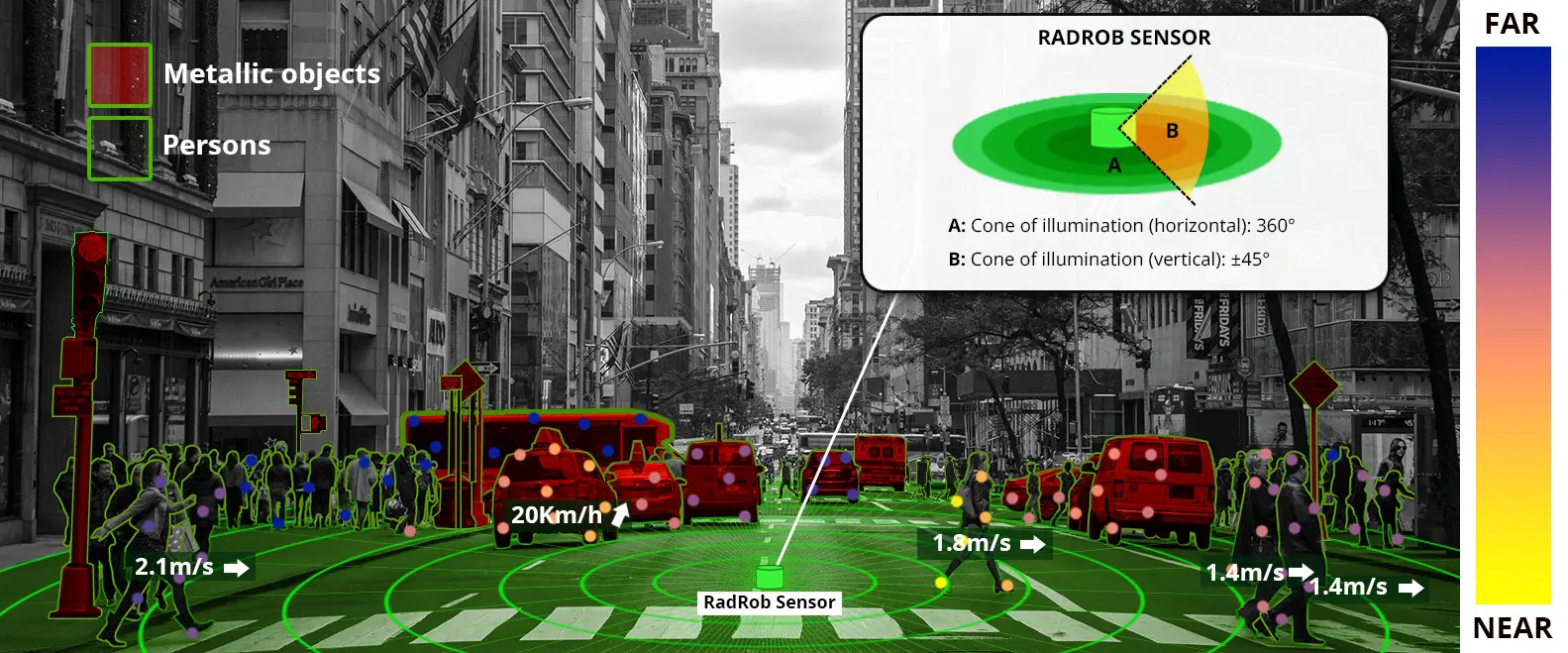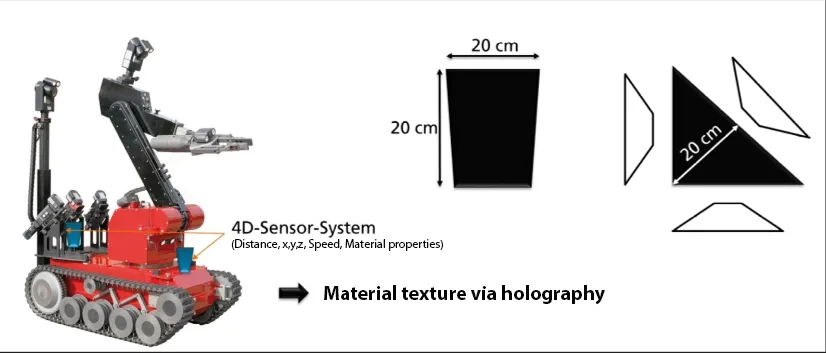RadRob a novel 3D-imaging sensor based on MIMO radar technology
3D-MIMO-Radar-System
a novel 3D-imaging sensor based on MIMO radar technology.
 The radar can distinguish between metallic objects and people and measure the speed and direction of their movement.
At the same time, it monitors 360° of the environment.
The integration of holography and secondary radar principles enable a wide range of applications: from documenting critical processes to monitoring the work areas of autonomously acting robots to allow them to operate in the work area shared with humans.
The radar can distinguish between metallic objects and people and measure the speed and direction of their movement.
At the same time, it monitors 360° of the environment.
The integration of holography and secondary radar principles enable a wide range of applications: from documenting critical processes to monitoring the work areas of autonomously acting robots to allow them to operate in the work area shared with humans. RadRob 3D-Imaging Sensors: Key Factors
- Exact detection of position and movement of persons (position better than 5 mm, max. speed 5 m/s, latency time less than 1 ms)
- Position determination of “smart objects” (accuracy better than 5 mm without time offset)
- Resolution: < 1 mm Field of view: 360° horizontal, ±45° vertical
- Tagging through secondary radar principle with passive tags
Project Description
Sensors for environmental monitoring of mobile and/or autonomous systems are becoming increasingly important in the coming years. On the commercial level, such systems typically operate in restricted areas. Within this project, the emphasis is on mobile robots for indoor applications.
In the research world, individual robots are mainly developed for home automation and healthcare applications, which are already being evaluated on humans. However, these robots usually exhibit:
a) Very cost-intensive systems, with the sensors and computational power being the main cost drivers.
b) At the same time, these systems have low force application capabilities. This means that in case of a disturbance, people should not be harmed.
Especially in industrial robotics, cost and high force application are crucial factors because force often correlates with the accuracy of the system when handling heavy loads.
The focus within this project is precisely on industrial robotics.
Sensors needed for industrial robots and to be developed within this project are called 3D imaging sensors. They enable continuous monitoring of the entire environment.
RadRob 3D-Imaging Sensors: the Pros
There are three different competing sensor technologies on the market today, which are also used in robotic systems (stereo camera systems, LiDAR, radar systems).
| Stereo-camera-System | LiDAR | Radar-Sensor | RadRob | |
|---|---|---|---|---|
Sample system: Microsoft Kinect | sample system: MRS6000 | Sample system: LRR4 | AiM of the project | |
| Auflösung | ||||
| Resolution | 2 mm @ 2 m | > 1 mm | > 10 mm | > 1 mm |
| Latenz | ||||
| Latency | <10 ms | <100 ms | 10 ms | < 1 ms |
| Position Bestimmung von Gegenständen | ||||
| Position determination of objects | Not possible | Not possible | Not possible | Possible with an accuracy of 5 mm |
| Field of view | ||||
| Field of view | 58° | 120° (horizontal) 15°(vertical) | 120° | 360° (horizontal) 45°(vertical) |
| Kosten | ||||
| Costs | 50 € | 6.500 € | 120 € | < 1000 € |
| Quelle | ||||
| Source | [1] | [2] | [3] | |
[1] „researchgate,“ [Online]. Available: https://www.researchgate.net/figure/The-Microsoft-Kinect-3D-Camera-Sensor-System-an-IR-transmitter-3D-Depth-Sensors_fig15_309740491. [Zugriff am 05 03 2021].
[2] P. Boulay und A. Debray, „LiDAR for Automtive and Industrial Applications,“ Yole Developpement, France, 2020.
[3] „bosch,“ [Online]. Available: https://www.bosch-mobility-solutions.com/en/products-and-services/passenger-cars-and-light-commercial-vehicles/driver-assistance-systems/automatic-emergency-braking/long-range-radar-sensor/. [Zugriff am 11 03 2021].


RadRob 3D-Imaging Sensors: Possible future areas of application for the technology
The 3D MIMO radar system can also be effectively utilized in many other areas:- Automotive industry
- Smart motion detectors
- Robots with shared workspace between humans and robots
- Avalanche detection, agriculture moisture sensing (MicroSens)
- Alert systems in nursing homes/hospitals
- UAV Detektion (MIMO Radar)
- UAV (Unmanned Aerial Vehicle) detection (MIMO Radar)
- Positioning of critical components (aviation)
- Traffic monitoring
- Robotaxis
- Conventional passenger vehicles (e.g., Mercedes S-Class Drive Pilot, also in mid-range vehicles)
- Golf radar sensors
